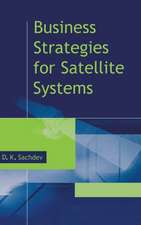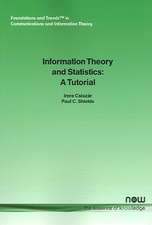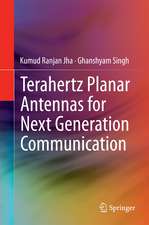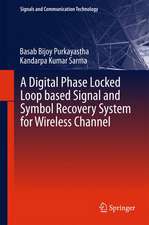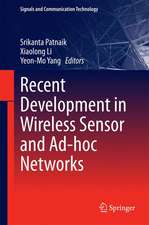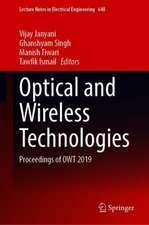Proceedings of the International Conference on Recent Cognizance in Wireless Communication & Image Processing: ICRCWIP-2014
Editat de Nitin Afzalpulkar, Vishnu Srivastava, Ghanshyam Singh, Deepak Bhatnagaren Limba Engleză Paperback – 8 sep 2018
| Toate formatele și edițiile | Preț | Express |
|---|---|---|
| Paperback (1) | 1597.74 lei 38-44 zile | |
| Springer India – 8 sep 2018 | 1597.74 lei 38-44 zile | |
| Hardback (1) | 1600.04 lei 38-44 zile | |
| Springer India – 28 apr 2016 | 1600.04 lei 38-44 zile |
Preț: 1597.74 lei
Preț vechi: 2102.29 lei
-24% Nou
Puncte Express: 2397
Preț estimativ în valută:
305.77€ • 318.05$ • 252.43£
305.77€ • 318.05$ • 252.43£
Carte tipărită la comandă
Livrare economică 11-17 aprilie
Preluare comenzi: 021 569.72.76
Specificații
ISBN-13: 9788132238041
ISBN-10: 8132238044
Pagini: 1002
Ilustrații: XXIX, 1002 p. 600 illus., 410 illus. in color.
Dimensiuni: 155 x 235 mm
Greutate: 0 kg
Ediția:Softcover reprint of the original 1st ed. 2016
Editura: Springer India
Colecția Springer
Locul publicării:New Delhi, India
ISBN-10: 8132238044
Pagini: 1002
Ilustrații: XXIX, 1002 p. 600 illus., 410 illus. in color.
Dimensiuni: 155 x 235 mm
Greutate: 0 kg
Ediția:Softcover reprint of the original 1st ed. 2016
Editura: Springer India
Colecția Springer
Locul publicării:New Delhi, India
Cuprins
A Noval Image Zooming Technique using Wavelet Coefficients.- Analysis of Operational Transformation Algorithms.- A Digital Image Watermarking Technique using Cascading of DCT and Biorthogonal Wavelet Transform.- Multi-Domain Image Enhancement of Foggy Images using Contrast Limited Adaptive Histogram Equalization Method.- Comparison of Various Reliability Measures of a Computer System with the Provision of Priority.- Dual Band Filter using DGS for X-Band Applications.- A Review on Performance Evaluation of Routing Protocols in MANET.- Retinal Nerve Fiber Layer analysis in Digital Fundus Images: Application to Early Glaucoma Diagnosis.- Design, Development of MC-CDMA & Reduction of ISI for Different Modulation Techniques.- A Compact Dual Wide Band Patch Antenna with Modified Ground Plane.- Contention Sensitive Routing for Mobile Ad Hoc Networks.- An analytical Approach for Fine Tuning of Resonant Frequency of MSPA using Dielectric Constant Engineering (DCE).- Design of Can Based Enhanced Event Data Recorder & Evidence Collecting System.- Detection of Brain Tumor in MRI Images, using Fuzzy C-Means Segmented Images and Artificial Neural Networks.- Multiple Inputs Combinational Logic Minimization by Minterms Set.- Design and Simulation of 16X8 Synchronous SRAM in 90nm CMOS Technology.- A Voltage-Mode Non-Linear-Synapse Neural Circuit for Bi-Partitioning of Graphs.- CNFET-Based Resistive Sensor Interface with Voltage/Current-Mode Readouts.- Design of CMOS Ring Oscillators with Low Phase Noise and Power Dissipation for Data Transmission in RF Range.- A Novel Hybrid Method for Segmentation of Ultrasound Images.- Temperature Sensor using a SMF-PCF-SMF Heterostructure.- investigation of Channel Drop Filter Based on Two Dimensional Photonic Crystal Structure.- Design and analysis of a Nano-Fiber with all-Normal and Flat Dispersion for Supercontinuum Generation.- Investigation of Semiconductor Optical Amplifier for DWDM System with 50GHz Channel Spacing.- Automatic License Plate Recognition System using Raspberry Pi.- Multiple Sink Data Aggregation.- Handwritten Devnagari Script Database Development for Off-line Hindi Character with Matra (Modifiers).- Part-of-Speech Tagging of Hindi Corpus using Rule-Based Method.- A Survey on Security Analysis in Cloud Computing.- Copper Nanofilm Antenna Design and Development: for X Band Wireless Sensor Applications. Vein Bio-Metric Template Security using Overlapped Shares Accounting for Minimum Storage.- Miniaturization of MEMs Based Smart Patch Antennas for Bio-Medical Applications.- Authentication of Primary User at Physical Layer through Approximation in Cognitive Radio.- Data Based Correlation Scheme.- A Comparative analysis of Different LFSR Based Ciphers and Parallel Computing Platforms for Development of Generic Cipher Compatible on Both Hardware and Software Platforms.- Generation of Automatic Variable Key to Make Secure Communication.- Vector Evaluated Genetic Algorithm Based Distributed Query Plan Generation in Distributed Database.- A Novel Mems Based Frequency Tunable Rectangular Patch Antenna.- Design and Optimization of Band Stop Filter using Metamaterial Structures for K-Band Applications.- Low Cost Crash Protection System for Heavy Motor Vehicles.- Effect of Parasitic Elements on the Performance of Buck-Boost Converter Used in PV System.- Effective Medium Approximation for Defining the Unavoidable Resistance of Solar Cell Front Contact.- A Novel Low Power Design Approach to Exploit the Power Usage of AMBA APB Bridge.- Solar Wind & Diesel Hybrid Energy System: A Review.- Analysis and Optimization of Stability for 6T SRAM Cell using 180nm Technology. Harvesting Electric Field Energy for Powering Wireless Sensors of Smart Grid.- Chalcogenide (LiGaSe2, LiGISe, LiGaS2): A Perfect Material to Design Highly Nonlinear PCFs for Supercontinuum Generation.- Machzehnder Interferometer: A Review of an Perfect all Optical Switching Structure.- Design and Analysis of Different Decoders for SAC-OCDMA Systems.- An Efficient Trust Based Routing Scheme using Max- Min Composition of Fuzzy Logic for MANET.- Modified D-Latch Enabled Bec-1 Carry Select Adder with Low Power Delay Product and Area Efficiency. Identification of Devanagari Script From Bilingual Printed Text Documents.- Ultra Wide Band Equal Power Divider using Stepped-Impedance Technology.- Implementation and Performance Analysis of Enhanced SHA-192.- Human Object Detection in Images using Shift-invariant Stationary Wavelet Transform.- A Novel Framework for Extracting Geospatial Information using SPARQL Query & Multiple Header Extraction Sources.- Secure Data Sharing with Data integrity in Public Clouds using Mediated Certificate-Less Encryption.- K-N Secrete Sharing Scheme of Visual Cryptography for Hiding Image using 2 X 2 Blocks Replacement.- Stepping Stone Detection Techniques: Classification and State-of-Art.- Cbir Feature Extraction using Neuro-Fuzzy Approach.- Multiband and Wideband antenna for Wi-Fi, Wlan, X-Band and Space Research Applications.- Triple Band Slotted Antenna for Wireless Applications.- A Compact Design of Modified E-Shaped Ground Plane Patch Antenna for Broadband Applications.- Frequency Switching in Coupled Microstrip Line Loaded with Split Ring Resonator.- A New Compact Dual Band Microstrip BPF for GSM-1800 and Wimax using Asymmetric Stepped Impedance Resonators.- Performance analysis of Zigbee Mesh Networks Under Nodes Failure.- Probabilistic Based Energy Efficient Dynamic Route Discovery in Manet's. A Survey Paper on Computational intelligence Approaches.- Simulation of Nonpolarp-GaN/i-InaGa(1-a)N/n-GaN Solar Cell for Maximum Efficiency.- Assessing the Severity of attacks in Wireless Networks.- SD and TCH Blocking KPI Improvement without Adding TRX Unit in BTS in GSM Network.- Design and analysis of Right-angled EBG Structure.- High Speed Packet Encoded Error Correction Technique for Wireless HD Video Streaming.- Review of Circular Polarization Techniques for Design of Microstrip Patch Antenna.- A Proposed Modification over Learning Vector Quantization & K-Means Algorithms for Performance Enhancement.- Taxonomy of Recent DDoS Attack Prevention, Detection and Response Schemes in Cloud Environment.- Design of Compact Concentric Circular Ring Patch antenna with Defected Ground Structure.- On the Bandwidth Enhancement of Modified Star-Triangular Fractal Antenna.- A Simple Miniaturized Dual Band Antenna for WiMAX/WLAN Applications.- Fault Detection for the Cluster Based System in Wireless Sensor Networks.- Gain and Bandwidth Enhancement of Single Layered Slotted Triangular Shaped Microstrip Patch antenna with Stub for Wlan Applications.- Design of Dual Resonator Broadband Multilayer Electromagnetic Coupled Microstrip antenna for X-Band Applications.- An Environment Aware Frequency Selective Head Set.- Performance analysis and Optimization of 40 Gbps Transmission System Over 4000 Km with FBG. Broadband Modified U Shaped Patch Antenna for Wireless Communication.- Performance Improvement of Epidemic Routing Protocol of Delay tolerant Networks By using Improved Buffer Management.- Elliptically Slotted Self Affine 8-Shaped Fractal Multiband Antenna.- Design of Compact Triangular Patch Antenna for WIMAX Applications.- Post Accident Assistance using on Board Diagnostics and Smart Phones.- Digital Image Forensics and Counter Anti-Forensics.- Can We Use Mass Based Similarity Measure in Classification?.- CNT Based Biomedical Sensor for Cancer Detection.- Effective Role of Thrashing in Load Balancing During VM Live Migration.- Real Time Abandoned Object Detection using Video Surveillance.- Request allocation and Resource Management Techniques in Cloud Computing.- Blind Image Watermarking of Variable Block Size for Copyright Protection.- Compact Goblet Shaped Single Band Notched UWB Antenna.- An Application of Firefly Algorithm for Clustering in Wireless Sensor Networks.- Microstrip Antenna with Defected Ground Structure (DGS) for Multiband Operation.- Design of a Compact Novel Planar Dual Band-Notched UWB Antenna.- X-Band and Ku-Band Patch antenna for Radiolocation Applications.- Procuring Wireless Sensor Actuator Network Security.- Performance analysis of Voip Over Wimax Networks under Nodes Failure.- Design of Reduced Order Controller for Mechanical System.- A Survey on Black-Hole attack in Manet.- Area Efficient FPGA Model of LMS Filtering Algorithm. An Efficient Hybrid- Cascaded Framework for Emission Computed tomography using Osem Image Reconstruction Algorithm.- A Review of Energy Efficient Routing Protocols in Wireless Sensor Networks.- A Study of Phase Shifting Surface.- Review on Student attendance Maintenance System: A Discontentment.
Notă biografică
Dr. Nitin Afzulpurkar started his research in late 80s focusing on robotics especially parallel robotic architectures and their implementations on transputer networks. He published several journal papers in this area and received a best conference paper award in 1989 in New Zealand. In the mid 90s his research interests turned to computer vision and its application for robotics. Here his initial work was on stereo vision algorithms and its implementation on robotic platforms. Currently one main area of his research is still computer vision with focus on tracking and identification of human, emotion and gesture recognition, application of machine vision for electronics industry. He has published extensively in international journals and conferences with two international best paper awards (Germany and Croatia) and has received three US patents in this area. In early 2000 he started his research on Microelectromechanical systems (MEMS) which forms a major area of his current research. He has published several papers in the top Journals in MEMS area and his book titled "Microfluidics and BioMEMS: Design, Fabrication and Applications" was published in 2009.
Dr Vishnu Srivastava is presently working as Chief Scientist and Head of the Microwave Tubes Division, CSIR-Central Electronics Engineering Research Institute (CSIR-CEERI), Pilani (Rajasthan), India, and as Professor of Ac-SIR (Academy for Scientific and Innovative Research, New Delhi). He received MSc degree in Physics from Rajasthan University, Jaipur, in 1975, and Ph.D. degree in Engineering from Lancaster University, U.K., in 1987. He was a commonwealth scholar from 1984 to 1987 in the UK, and was Junior Research Fellow at Rajasthan University during 1975. He joined CSIR-CEERI, Pilani in January 1976. At CEERI, he was involved with the design and development of various types of high power vacuum microwave devices for communication and Radars. He developed X-band 200kW tunable Coaxial Magnetron for ECCM Radars. He developed space-qualified C-band 60W TWT and Ku-band 140W TWT for satellite communication. He developed SUNRAY-codes for small-signal and large signal analysis of beam-wave interaction in TWTs. His successfully developed SUNRAY-1D software code for multi-signal analysis of beam-wave interaction in TWTs, was exported to UK., and was also purchased by MTRDC (DRDO), Bangalore. He developed technologies for the successful development of high efficiency vacuum microwave amplifiers (Space TWTs) for satellite communication. Presently, he is associated with the design and development of vacuum microelectronic devices for THz communication – requiring innovations in MEMS technologies (UV LIGA processes) for such devices. He has more than 120 research publications in different national and international journals, and has already guided 8 PhD. students and more than 60 ME/MTech students. He received IETE - JC Bose memorial awards for best engineering paper and best project team . He is a fellow of IETE and VEDA Society, and senior member of IEEE , CSI, IPA, IVS, PSI and IFTA. Recently, he was awarded Honorary Fellowship of Society for Education & Research Development (SERD), New Delhi. His present interests are in the design and development of high efficiency, high power vacuum microelectronic devices for mm- and sub-mm-wave frequencies.
Dr. Ghanshyam Singh has more than 15 years of teaching and research experience and is currently an Associate Professor in the Department of Electronics & Communication Engineering at Malaviya National Institute of Technology Jaipur, India. He obtained his Bachelor's degree in Electronics & Communication Engineering from National Institute of Technology Silchar, Assam, India and his Master's and PhD degrees in Electronics & Communication Engineering from Malaviya National Institute of Technology Jaipur, India. He has guided more than 20 master's theses and presently guiding 6 PhD research scholars. His areas of research interest include Optical Communication Engineering, Optical Switches, Optical Logic Gates & Circuits, Photonic Crystal Fibers, Nano-photonics, Nano-optical structures, RF & Microwave devices, Microstrip and Smart Antennas. He has worked with the Optics group at the Department of Physics, Herriot Watt University, Edinburgh, UK. under the research grant from TEQIP, Govt. of India. He had also been a recipient of CIMO fellowship from Govt. of Finland to work with photonics groups at Nanofabrication laboratory, Dept. of Physics and Mathematics, University of Eastern Finland, Joensuu, Finland. He has been a visiting Professor at Tsuda labs, Dept. of EEE, KEIO University, Hiyoshi Campus, Japan and participated in IKSS, Krutyn Poland. Presently engaged in a DST-JSPS sponsored research project with Prof. Hiroyuki Tsuda & Group, KEIO University, Japan (Period: 2014-2016). He is presently a member of IEEE Photonic Society, SPIE, Optical Society of America (OSA), Optical Society of India (OSI), Indian Laser Society (ILA), Broadcast Engineering Society of India (BESI), IETE India, Institute of Engineers India, and Indian Society for Technical Education (ISTE).
Dr. Deepak Bhatnagar received his Master's and Ph.D. degrees in Physics from University of Rajasthan, Jaipur, India in 1981 and 1986, respectively. He is currently Associate Professor in Physics, University of Rajasthan, Jaipur and leads a group of 14 researchers in the microwave area. He has published over 140 papers in international and national journals and conference proceedings. His main area of interest is the design of compact wideband and circularly polarized patch antennas for modern communication systems. Dr. Bhatnagar is senior member of IEEE, Fellow of IETE (India) and life member of several other societies. He is Chairman of IEEE MTT-S India Council. He is currently working as a professor in the Department of Physics University of Rajasthan, and Director- Center for Convergence of Technology, Govt. of Rajasthan.
Dr Vishnu Srivastava is presently working as Chief Scientist and Head of the Microwave Tubes Division, CSIR-Central Electronics Engineering Research Institute (CSIR-CEERI), Pilani (Rajasthan), India, and as Professor of Ac-SIR (Academy for Scientific and Innovative Research, New Delhi). He received MSc degree in Physics from Rajasthan University, Jaipur, in 1975, and Ph.D. degree in Engineering from Lancaster University, U.K., in 1987. He was a commonwealth scholar from 1984 to 1987 in the UK, and was Junior Research Fellow at Rajasthan University during 1975. He joined CSIR-CEERI, Pilani in January 1976. At CEERI, he was involved with the design and development of various types of high power vacuum microwave devices for communication and Radars. He developed X-band 200kW tunable Coaxial Magnetron for ECCM Radars. He developed space-qualified C-band 60W TWT and Ku-band 140W TWT for satellite communication. He developed SUNRAY-codes for small-signal and large signal analysis of beam-wave interaction in TWTs. His successfully developed SUNRAY-1D software code for multi-signal analysis of beam-wave interaction in TWTs, was exported to UK., and was also purchased by MTRDC (DRDO), Bangalore. He developed technologies for the successful development of high efficiency vacuum microwave amplifiers (Space TWTs) for satellite communication. Presently, he is associated with the design and development of vacuum microelectronic devices for THz communication – requiring innovations in MEMS technologies (UV LIGA processes) for such devices. He has more than 120 research publications in different national and international journals, and has already guided 8 PhD. students and more than 60 ME/MTech students. He received IETE - JC Bose memorial awards for best engineering paper and best project team . He is a fellow of IETE and VEDA Society, and senior member of IEEE , CSI, IPA, IVS, PSI and IFTA. Recently, he was awarded Honorary Fellowship of Society for Education & Research Development (SERD), New Delhi. His present interests are in the design and development of high efficiency, high power vacuum microelectronic devices for mm- and sub-mm-wave frequencies.
Dr. Ghanshyam Singh has more than 15 years of teaching and research experience and is currently an Associate Professor in the Department of Electronics & Communication Engineering at Malaviya National Institute of Technology Jaipur, India. He obtained his Bachelor's degree in Electronics & Communication Engineering from National Institute of Technology Silchar, Assam, India and his Master's and PhD degrees in Electronics & Communication Engineering from Malaviya National Institute of Technology Jaipur, India. He has guided more than 20 master's theses and presently guiding 6 PhD research scholars. His areas of research interest include Optical Communication Engineering, Optical Switches, Optical Logic Gates & Circuits, Photonic Crystal Fibers, Nano-photonics, Nano-optical structures, RF & Microwave devices, Microstrip and Smart Antennas. He has worked with the Optics group at the Department of Physics, Herriot Watt University, Edinburgh, UK. under the research grant from TEQIP, Govt. of India. He had also been a recipient of CIMO fellowship from Govt. of Finland to work with photonics groups at Nanofabrication laboratory, Dept. of Physics and Mathematics, University of Eastern Finland, Joensuu, Finland. He has been a visiting Professor at Tsuda labs, Dept. of EEE, KEIO University, Hiyoshi Campus, Japan and participated in IKSS, Krutyn Poland. Presently engaged in a DST-JSPS sponsored research project with Prof. Hiroyuki Tsuda & Group, KEIO University, Japan (Period: 2014-2016). He is presently a member of IEEE Photonic Society, SPIE, Optical Society of America (OSA), Optical Society of India (OSI), Indian Laser Society (ILA), Broadcast Engineering Society of India (BESI), IETE India, Institute of Engineers India, and Indian Society for Technical Education (ISTE).
Dr. Deepak Bhatnagar received his Master's and Ph.D. degrees in Physics from University of Rajasthan, Jaipur, India in 1981 and 1986, respectively. He is currently Associate Professor in Physics, University of Rajasthan, Jaipur and leads a group of 14 researchers in the microwave area. He has published over 140 papers in international and national journals and conference proceedings. His main area of interest is the design of compact wideband and circularly polarized patch antennas for modern communication systems. Dr. Bhatnagar is senior member of IEEE, Fellow of IETE (India) and life member of several other societies. He is Chairman of IEEE MTT-S India Council. He is currently working as a professor in the Department of Physics University of Rajasthan, and Director- Center for Convergence of Technology, Govt. of Rajasthan.
Textul de pe ultima copertă
Thisvolume comprises the proceedings of the International Conference on RecentCognizance in Wireless Communication & Image Processing. It brings togethercontent from academicians, researchers, and industry experts in areas ofWireless Communication and Image Processing. The volume provides a snapshot ofcurrent progress in computational creativity and a glimpse of futurepossibilities. The proceedings include two kinds of paper submissions: (i) regular papers addressing foundation issues, describing original research oncreative systems development and modeling; and (ii) position papers describingwork-in-progress or research directions for computational creativity. This workwill be useful to professionals and researchers working in the core areas of wirelesscommunications and image processing.
Caracteristici
Presents a detailed analysis on recent developments in wireless communication & image processing
Covers research in key areas in wireless communication, microwave engineering, image processing and circuit design for applications in these areas
Presents new ideas and directions for future research
Includes supplementary material: sn.pub/extras
Covers research in key areas in wireless communication, microwave engineering, image processing and circuit design for applications in these areas
Presents new ideas and directions for future research
Includes supplementary material: sn.pub/extras






